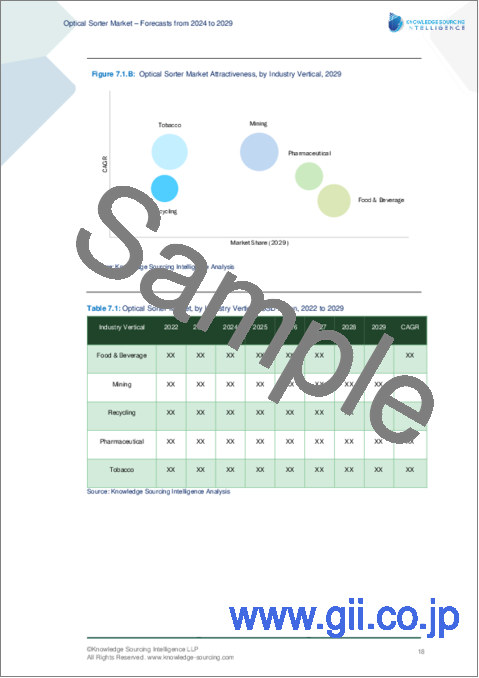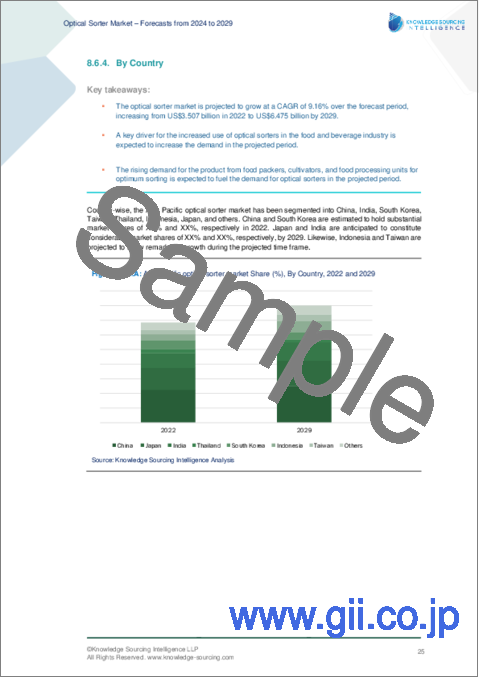|
|
市場調査レポート
商品コード
1457059
光学選別機市場 - 2024年~2029年までの予測Optical Sorter Market - Forecasts from 2024 to 2029 |
||||||
カスタマイズ可能
|
|||||||
| 光学選別機市場 - 2024年~2029年までの予測 |
|
出版日: 2024年02月08日
発行: Knowledge Sourcing Intelligence
ページ情報: 英文 124 Pages
納期: 即日から翌営業日
|
全表示
- 概要
- 目次
光学選別機市場は2022年に35億700万米ドルと評価され、CAGR 9.16%で成長し、2029年には64億7,500万米ドルの市場規模に達します。
固形物選別機または光学選別機は、選別専用の自動機械です。光学選別機では、選別は複数の専用システムによって自動的に行われます。色、大きさ、形、構造、化学成分、農産物種子、コーヒー、菓子類、果物、ナッツ類、食肉、工業用鉱物や貴金属など様々なパラメータによって選別されます。世界的に見て、光学選別機市場は、生産性を向上させる産業における自動化の進展や、食品産業における配送・加工手順の短縮ニーズの高まりが主な要因となっています。また、食品安全に関する政府の厳しい規制や、こうした規制に伴う人件費の増加も市場の成長をもたらしています。市場の競争は激化しており、各社は継続的に新製品を発表しています。例えば、サタケUSAは2020年10月に開催されたPack Expo Las VegasでFMSR-IR 光学選別機の発売を発表しました。サタケのFMSR-IRシリーズは、サタケの最新のRGBテクノロジー、IRイメージング、形状選別技術を1台の機械に統合したもので、変色や異物、種やナッツの不規則な形状などの不要物を除去します。TOMRA 3C光選別システムは2020年5月にトマラによって導入され、比類のない選別効率と歩留まりを提供します。
世界市場では、さまざまな要因が需要を後押ししています。人工知能がほぼすべての産業分野やさまざまなエンドユーザー産業で成長していることから、世界の光学選別機市場は高い成長が見込まれています。光学選別機には、生産性の向上、商品の品質向上、人件費の削減など、数多くのメリットがあります。その他、技術の進歩も自動ソーターシステムのスムーズな操作に貢献しており、予測期間中の市場成長率の上昇につながっています。
市場促進要因:
- 食品業界における光学選別機の利用拡大。
光学選別機は、近年の検出器技術とインテリジェント・ソフトウェアの進歩により、製品の品質向上、歩留まりの最適化、さまざまな加工側面の認識が可能になった。光学選別機は飛躍的な進歩を遂げましたが、操作の難しさなど、いくつかの課題に直面しています。これらの課題は、新しいソフトウェアの開発により、拒絶仕様をコントロールする使いやすいマシンを消費者に提供することで解決されつつあります。食品業界では、生産能力を拡大するために納期や処理時間を大幅に短縮する必要があり、光学選別機に対するニーズが高まっています。
- 品質管理に対するニーズの高まりは、市場を大きく押し上げると予想されます。
光学選別機市場は、品質管理に対する要求の高まりによって成長しています。あらゆる分野の企業が厳しい要件を満たし、高品質な商品を提供することに重点を置くようになり、光学選別技術は不可欠なツールとなっています。生産プロセスにおいて、高性能センサーとカメラを搭載した光学選別機は、不良品や破損品を正確かつ効果的に見つけ出し、取り除く方法を提供します。光学選別は、不純物の排除を保証し、製品の品質が重要な飲食品などの分野で安全規制を守るために不可欠です。食品の安全性、環境の持続可能性、全体的な製品の品質保証に関する規制基準を遵守することが求められるため、光学選別機の必要性が高まっています。
市場抑制要因
- 高コスト:
光学選別機は高度な技術を使用しているため、コストが高いです。しかし、光学選別機は初期費用が高いため、生産性の向上や製品品質の改善に役立つとはいえ、予算が限られている潜在的なエンドユーザーは敬遠しがちです。初期費用が高額なため、予算が限られているユーザーには導入しにくいです。先進技術であるこの自動ソーター・システムは高価であるため、すべての人が購入することはできず、市場の成長を妨げています。
北米の光学選別機市場は大きく成長すると予想されます。
さまざまな分野で光学式ソーター技術の利用が拡大している背景には、北米の光学選別機市場を牽引する数多くの重要な要因があります。この地域では品質管理と食品の安全性が重視されているため、飲食品業界における光学選別機の利用が増加しています。これらの技術は、不純物や不良品を効果的に識別・除去します。また、持続可能な社会の実現に向け、環境への配慮やリサイクルプログラムも、リサイクル施設への光学選別機の導入を後押ししています。光学選別機の精度と能力は、センサー技術、特にカメラとハイパースペクトルイメージングの開発によって向上しており、革新的なソリューションを求める企業にとってより魅力的なものとなっています。
主な発展:
- 2022年6月、小麦、ライ麦、オート麦、穀物、コーヒー、豆類用の最新光学選別機であるSORTEX H SpectraVisionがSwiss Buhler Groupから発売されました。画期的な新しい選別アルゴリズムMerlinAiを採用し、光学選別における製品のトレーサビリティ、性能、使いやすさの水準を引き上げました。 2021年6月、サタケはサイズ・容量ともに最新・最大の光学選別機「NIRAMIシリーズ」の発売を発表しました。穀物、豆類、種子類など、幅広い品目を効率よく選別する高機能光学選別機「NIRAMI」のスペックが進化。ニラミはサイズバリエーションが豊富で、シュート幅も非常に広く、調整も可能なため、幅広い用途・処理能力に対応します。
目次
第1章 イントロダクション
- 市場概要
- 市場の定義
- 調査範囲
- 市場セグメンテーション
- 通貨
- 前提条件
- 基準年と予測年のタイムライン
- 利害関係者にとっての主なメリット
第2章 調査手法
- 調査デザイン
- 調査プロセス
第3章 エグゼクティブサマリー
- 主な調査結果
- CXOの視点
第4章 市場力学
- 市場促進要因
- 市場抑制要因
- ポーターのファイブフォース分析
- 業界バリューチェーン分析
- アナリストビュー
第5章 光学選別機市場:製品別
- イントロダクション
- MIRソーター
- 市場動向と機会
- 成長の見通し
- 地理的な収益性
- NIRソーター
- 市場動向と機会
- 成長の見通し
- 地理的な収益性
- RGBカラーソーター
- 市場動向と機会
- 成長の見通し
- 地理的な収益性
- その他
- 市場動向と機会
- 成長の見通し
- 地理的な収益性
第6章 光学選別機市場:プラットフォーム別
- イントロダクション
- ベルト
- 市場動向と機会
- 成長の見通し
- 地理的な収益性
- フリーフォール
- 市場動向と機会
- 成長の見通し
- 地理的な収益性
- レーン
- 市場動向と機会
- 成長の見通し
- 地理的な収益性
- ハイブリッド
- 市場動向と機会
- 成長の見通し
- 地理的な収益性
第7章 光学選別機市場:業界別
- イントロダクション
- 飲食品
- 市場動向と機会
- 成長の見通し
- 地理的な収益性
- 鉱業
- 市場動向と機会
- 成長の見通し
- 地理的な利益性
- リサイクル
- 市場動向と機会
- 成長の見通し
- 地理的な収益性
- 医薬品
- 市場動向と機会
- 成長の見通し
- 地理的な収益性
- タバコ
- 市場動向と機会
- 成長の見通し
- 地理的な利益性
第8章 光学選別機市場:地域別
- イントロダクション
- 北米
- 製品別
- プラットフォーム別
- 業界別
- 国別
- 南米
- 製品別
- プラットフォーム別
- 業界別
- 国別
- 欧州
- 製品別
- プラットフォーム別
- 業界別
- 国別
- 中東・アフリカ
- 製品別
- プラットフォーム別
- 業界別
- 国別
- アジア太平洋
- 製品別
- プラットフォーム別
- 業界別
- 国別
第9章 競合環境と分析
- 主要企業と戦略分析
- 市場シェア分析
- 合併、買収、合意およびコラボレーション
- 競争力のあるダッシュボード
第10章 企業プロファイル
- Tomra
- Binder+Co AG
- Greefa
- NATIONAL RECOVERY TECHNOLOGIES, LLC
- Raytec Vision S.p.A.
- CP Manufacturing, Inc
- Sesotec GmbH
- Buhler AG
- Steinert GmbH
- Duravant
The optical sorter market is evaluated at US$3.507 billion for the year 2022 growing at a CAGR of 9.16% reaching the market size of US$6.475 billion by the year 2029.
A solid products sorter or optical sorter is a dedicated automated machine used for sorting. In an optical sorter, the sorting is carried out automatically by several dedicated systems. Objects are sorted by various parameters, including color, size, shape, structure, chemical make-up, agricultural seeds, coffee, confectioneries, fruits, nuts, meat, and industrial minerals or precious metals. Globally, the optical sorter market is primarily driven by the increasing automation in industries that increase productivity and the growing need in the food industry to reduce the length of delivery and processing procedures. The market is also experiencing growth due to the strict government regulations regarding food security as well as the increased labor costs associated with these regulations. The market is becoming more competitive, with companies continually launching new products; for instance, Satake USA announced the launch of the FMSR-IR optical sorter at Pack Expo Las Vegas in October 2020. Satake's FMSR-IR series combines Satake's latest RGB technology, IR imaging, and shape-sorting technologies in a single machine that removes unwanted materials like discoloration, foreign items, as well as irregular shapes from seeds and nuts. The TOMRA 3C optical sorting system was introduced by Tomara in May 2020, providing unparalleled sorting efficiency and yields.
In the global market, various factors drive demand. With Artificial Intelligence growing in almost every industrial sector as well as a variety of end-user industries, the global optical sorter market is anticipated to experience high growth. An optical sorter has numerous advantages, including increased productivity, quality commodities, and labor cost reduction. Other advances in technologies also contribute to the smooth operation of automated sorter systems, leading to higher market growth during the forecast period.
MARKET DRIVERS:
- Growing utilization of optical sorter in food industry.
Optical sorters have been able to improve product quality, optimize yield, and recognize various processing aspects because of recent advancements in detector technology and intelligent software. Although optical sorters have made tremendous strides, manufacturers still face several challenges, mainly in the way that they are difficult to operate. These challenges are being met by new software developments that provide consumers with easy-to-use machines that control rejection specifications. There is a growing need for optical sorters in the food industry as delivery and processing times need to be reduced considerably to expand production capacity.
- Increased need for quality control is anticipated to significantly upsurge the market.
The optical sorters market is growing as a result of the increased demand for quality control. Optical sorting technologies become essential tools as firms from all sectors increase their focus on meeting strict requirements and providing high-quality goods. During the production process, optical sorters with sophisticated sensors and cameras offer an accurate and effective way to locate and remove subpar or damaged goods. Optical sorting is vital for guaranteeing the elimination of impurities and upholding safety regulations in sectors like food and beverage, where product quality is critical. The requirement to adhere to regulatory criteria about food safety, environmental sustainability, and overall product quality assurance amplifies the need for optical sorters.
MARKET RESTRAINTS:
- High cost:
The cost of optical sorting equipment is higher because it uses advanced technologies. However, optical sorters come at a high initial cost, which can deter potential end-users with controlled budgets even though they can help increase productivity and improve product quality. Since it is expensive initially, many users cannot afford to use it under tight budgets. As an advanced technology, this automated sorter system is expensive and therefore cannot be purchased by all, which hampers the market's growth.
The North American optical sorter market is anticipated to grow significantly.
Numerous important factors that together contribute to the growing usage of optical sorting technologies across various sectors are driving the North American optical sorter market. The usage of optical sorters in the food and beverage industry has increased due to the region's strong emphasis on quality control and food safety. These technologies effectively identify and remove impurities and faulty goods. In line with sustainability objectives, environmental consciousness, and recycling programs have also encouraged the installation of optical sorters in recycling facilities. The precision and capacities of optical sorters are improved by developments in sensor technology, especially in cameras and hyperspectral imaging, which makes them more appealing to companies looking for innovative solutions.
Key Developments:
- In October 2023, The FP7000 spectral cell sorter, which uses proprietary spectral technology-based optics, sophisticated electronics, and fluidics to provide high-speed, high-parameter sorting with more than 44 colors and straightforward workflows, was launched by Sony Corporation.
- In June 2022, The SORTEX H SpectraVision, the newest optical sorter for wheat, rye, oats, grains, coffee, and pulses was launched by Swiss Buhler Group. With the use of revolutionary new MerlinAi sorting algorithms, the solution raises the bar for product traceability, performance, and usability in optical sorting.
- In June 2021, Satake announced the launch of the "NIRAMI series," their newest and biggest optical sorter in terms of both size and capacity. With its advanced specifications, Satake's "NIRAMI" high-performance optical sorter effectively sorts a wide range of items, including grains, pulses, and seeds. Since Nirami comes in a range of sizes and has extremely broad chutes and adjustable configurations, it is perfect for a wide range of applications and processing capabilities.
Segmentation:
By Product
- MIR Sorter
- NIR Sorters
- RGB Color Sorters
- Others
By Platform
- Belt
- Freefall
- Lane
- Hybrid
By Industry Vertical
- Food & Beverage
- Mining
- Recycling
- Pharmaceutical
- Tobacco
By Geography
- North America
- USA
- Canada
- Mexico
- Others
- South America
- Brazil
- Argentina
- Others
- Europe
- Germany
- France
- United Kingdom
- Others
- Middle East and Africa
- Saudi Arabia
- Israel
- Others
- Asia Pacific
- China
- India
- South Korea
- Taiwan
- Thailand
- Indonesia
- Japan
- Others
TABLE OF CONTENTS
1. INTRODUCTION
- 1.1. Market Overview
- 1.2. Market Definition
- 1.3. Scope of the Study
- 1.4. Market Segmentation
- 1.5. Currency
- 1.6. Assumptions
- 1.7. Base, and Forecast Years Timeline
- 1.8. Key Benefits to the stakeholder
2. RESEARCH METHODOLOGY
- 2.1. Research Design
- 2.2. Research Processes
3. EXECUTIVE SUMMARY
- 3.1. Key Findings
- 3.2. CXO Perspective
4. MARKET DYNAMICS
- 4.1. Market Drivers
- 4.2. Market Restraints
- 4.3. Porter's Five Forces Analysis
- 4.3.1. Bargaining Power of Suppliers
- 4.3.2. Bargaining Power of Buyers
- 4.3.3. Threat of New Entrants
- 4.3.4. Threat of Substitutes
- 4.3.5. Competitive Rivalry in the Industry
- 4.4. Industry Value Chain Analysis
- 4.5. Analyst View
5. OPTICAL SORTER MARKET, BY PRODUCT
- 5.1. Introduction
- 5.2. MIR Sorter
- 5.2.1. Market Trends and Opportunities
- 5.2.2. Growth Prospects
- 5.2.3. Geographic Lucrativeness
- 5.3. NIR Sorters
- 5.3.1. Market Trends and Opportunities
- 5.3.2. Growth Prospects
- 5.3.3. Geographic Lucrativeness
- 5.4. RGB Color Sorters
- 5.4.1. Market Trends and Opportunities
- 5.4.2. Growth Prospects
- 5.4.3. Geographic Lucrativeness
- 5.5. Others
- 5.5.1. Market Trends and Opportunities
- 5.5.2. Growth Prospects
- 5.5.3. Geographic Lucrativeness
6. OPTICAL SORTER MARKET, BY PLATFORM
- 6.1. Introduction
- 6.2. Belt
- 6.2.1. Market Trends and Opportunities
- 6.2.2. Growth Prospects
- 6.2.3. Geographic Lucrativeness
- 6.3. Freefall
- 6.3.1. Market Trends and Opportunities
- 6.3.2. Growth Prospects
- 6.3.3. Geographic Lucrativeness
- 6.4. Lane
- 6.4.1. Market Trends and Opportunities
- 6.4.2. Growth Prospects
- 6.4.3. Geographic Lucrativeness
- 6.5. Hybrid
- 6.5.1. Market Trends and Opportunities
- 6.5.2. Growth Prospects
- 6.5.3. Geographic Lucrativeness
7. OPTICAL SORTER MARKET, BY INDUSTRY VERTICAL
- 7.1. Introduction
- 7.2. Food & Beverage
- 7.2.1. Market Trends and Opportunities
- 7.2.2. Growth Prospects
- 7.2.3. Geographic Lucrativeness
- 7.3. Mining
- 7.3.1. Market Trends and Opportunities
- 7.3.2. Growth Prospects
- 7.3.3. Geographic Lucrativeness
- 7.4. Recycling
- 7.4.1. Market Trends and Opportunities
- 7.4.2. Growth Prospects
- 7.4.3. Geographic Lucrativeness
- 7.5. Pharmaceutical
- 7.5.1. Market Trends and Opportunities
- 7.5.2. Growth Prospects
- 7.5.3. Geographic Lucrativeness
- 7.6. Tobacco
- 7.6.1. Market Trends and Opportunities
- 7.6.2. Growth Prospects
- 7.6.3. Geographic Lucrativeness
8. OPTICAL SORTER MARKET, BY GEOGRAPHY
- 8.1. Introduction
- 8.2. North America
- 8.2.1. By Product
- 8.2.2. By Platform
- 8.2.3. By Industry Vertical
- 8.2.4. By Country
- 8.2.4.1. USA
- 8.2.4.1.1. Market Trends and Opportunities
- 8.2.4.1.2. Growth Prospects
- 8.2.4.2. Canada
- 8.2.4.2.1. Market Trends and Opportunities
- 8.2.4.2.2. Growth Prospects
- 8.2.4.3. Mexico
- 8.2.4.3.1. Market Trends and Opportunities
- 8.2.4.3.2. Growth Prospects
- 8.2.4.1. USA
- 8.3. South America
- 8.3.1. By Product
- 8.3.2. By Platform
- 8.3.3. By Industry Vertical
- 8.3.4. By Country
- 8.3.4.1. Brazil
- 8.3.4.1.1. Market Trends and Opportunities
- 8.3.4.1.2. Growth Prospects
- 8.3.4.2. Argentina
- 8.3.4.2.1. Market Trends and Opportunities
- 8.3.4.2.2. Growth Prospects
- 8.3.4.3. Others
- 8.3.4.3.1. Market Trends and Opportunities
- 8.3.4.3.2. Growth Prospects
- 8.3.4.1. Brazil
- 8.4. Europe
- 8.4.1. By Product
- 8.4.2. By Platform
- 8.4.3. By Industry Vertical
- 8.4.4. By Country
- 8.4.4.1. Germany
- 8.4.4.1.1. Market Trends and Opportunities
- 8.4.4.1.2. Growth Prospects
- 8.4.4.2. France
- 8.4.4.2.1. Market Trends and Opportunities
- 8.4.4.2.2. Growth Prospects
- 8.4.4.3. United Kingdom
- 8.4.4.3.1. Market Trends and Opportunities
- 8.4.4.3.2. Growth Prospects
- 8.4.4.4. Others
- 8.4.4.4.1. Market Trends and Opportunities
- 8.4.4.4.2. Growth Prospects
- 8.4.4.1. Germany
- 8.5. Middle East and Africa
- 8.5.1. By Product
- 8.5.2. By Platform
- 8.5.3. By Industry Vertical
- 8.5.4. By Country
- 8.5.4.1. Saudi Arabia
- 8.5.4.1.1. Market Trends and Opportunities
- 8.5.4.1.2. Growth Prospects
- 8.5.4.2. Israel
- 8.5.4.2.1. Market Trends and Opportunities
- 8.5.4.2.2. Growth Prospects
- 8.5.4.3. Others
- 8.5.4.3.1. Market Trends and Opportunities
- 8.5.4.3.2. Growth Prospects
- 8.5.4.1. Saudi Arabia
- 8.6. Asia Pacific
- 8.6.1. By Product
- 8.6.2. By Platform
- 8.6.3. By Industry Vertical
- 8.6.4. By Country
- 8.6.4.1. China
- 8.6.4.1.1. Market Trends and Opportunities
- 8.6.4.1.2. Growth Prospects
- 8.6.4.2. India
- 8.6.4.2.1. Market Trends and Opportunities
- 8.6.4.2.2. Growth Prospects
- 8.6.4.3. South Korea
- 8.6.4.3.1. Market Trends and Opportunities
- 8.6.4.3.2. Growth Prospects
- 8.6.4.4. Taiwan
- 8.6.4.4.1. Market Trends and Opportunities
- 8.6.4.4.2. Growth Prospects
- 8.6.4.5. Thailand
- 8.6.4.5.1. Market Trends and Opportunities
- 8.6.4.5.2. Growth Prospects
- 8.6.4.6. Indonesia
- 8.6.4.6.1. Market Trends and Opportunities
- 8.6.4.6.2. Growth Prospects
- 8.6.4.7. Japan
- 8.6.4.7.1. Market Trends and Opportunities
- 8.6.4.7.2. Growth Prospects
- 8.6.4.8. Others
- 8.6.4.8.1. Market Trends and Opportunities
- 8.6.4.8.2. Growth Prospects
- 8.6.4.1. China
9. COMPETITIVE ENVIRONMENT AND ANALYSIS
- 9.1. Major Players and Strategy Analysis
- 9.2. Market Share Analysis
- 9.3. Mergers, Acquisitions, Agreements, and Collaborations
- 9.4. Competitive Dashboard
10. COMPANY PROFILES
- 10.1. Tomra
- 10.2. Binder+Co AG
- 10.3. Greefa
- 10.4. NATIONAL RECOVERY TECHNOLOGIES, LLC
- 10.5. Raytec Vision S.p.A.
- 10.6. CP Manufacturing, Inc
- 10.7. Sesotec GmbH
- 10.8. Buhler AG
- 10.9. Steinert GmbH
- 10.10. Duravant





